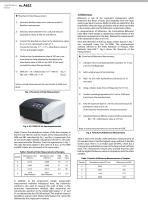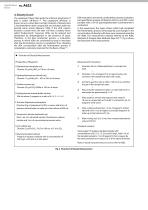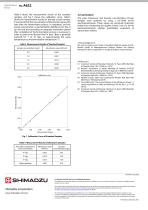
Catalog excerpts

Spectrophotometric Analysis Measurement of Color, Bitterness, and Diacetyl Content of Beer Using UV-Vis Spectrophotometer Among alcoholic beverages, beer is extremely popular and enjoys a strong market, and diverse beers with distinctive individual characters, exemplified by craft beers, have sold well in recent years. Although sensory evaluation is an essential technique, evaluations using various types of analytical instruments are also effective for ensuring the uniform quality of these beers. The UV-Vis spectrophotometer is one useful instrument for beer analysis. The standard international methods for sensory evaluation of beer are the methods of the American Society of Brewing Chemists (ASBC) and the European Brewery Convention (EBC), and in Japan, the Brewery Convention of Japan (BCOJ), centering on major beer producers, has established analytical methods for beer. Among the 12 inspection items in the ASBC Methods of Analysis, color (Beer-10) and bitterness (Beer-23) are inspected by UV-Vis spectrophotometry. UV-Vis spectrophotometry also makes it possible to analyze the diacetyl, iron, polyphenol, and other components contained in beer. This article introduces measurements of the color, bitterness, and diacetyl content of commercially-available beers using a Shimadzu UV-1900i UV-Vis spectrophotometer. K. Kawahara, K. Maruyama Table 1 Types and Features of Measurement Samples Type Belgian white Color is extremely light, and has a spicy, acidic taste. Has a clean, refreshing taste. World’s most widely-consumed type. The main beers of major beer producers are this type. Yellow-gold color. Has a strong aroma and bitter taste due to the Indian pale ale large amount of hops used. Alcohol content is (IPA) also high. Pale ale Gold to copper color. Rich aroma is a distinctive feature. Color Beer has a wide range of colors, from the light-colored beers called white ale to black beers such as stout. The units used to express the color intensity of beer are the SRM (Standard Reference Method) system specified by the ASBC and the EBC (European Brewery Convention) system of the EBC. In these standards, the values are calculated using the absorbance of a single wavelength. Fig. 2 shows a reference diagram of the colors in these two systems. Measurement Samples (Color and Bitterness) Four types of commercially-available beer were prepared, and their color and bitterness were measured. Fig. 1 shows the appearance of the measurement samples, and Table 1 shows the details of each sample. D Fig. 2 Reference Diagram of Colors in SRM and EBC Systems Fig. 1 Appearance of Measurement Samples The colors of the four beers shown in Fig. 1 were measured using a Shimadzu UV-1900i. The measurement method referred to ASBC Methods of Analysis, Beer Methods, Beer10A (1) and the BCOJ Beer Analysis Methods, 8.15 Bitterness Unit (2). Fig. 3 shows the flowchart of the measurement, and Fig. 4 shows the measurement instrument. Although absorbance value at 430 nm is used in color calculations, absorbance value at 700 nm is also measured to check turbidity.
Open the catalog to page 1
Flowchart of Color Measurement 1) Introduce distilled water into a cell and conduct a baseline measurement. Introduce deaerated beer into a cell, and measure absorbance values at 430 nm and 700 nm. Convert the absorbance values to the absorbance values for a 1/2 inch optical path length (A1/2). Conversion formula A1/2 = 1.27 × (Absorbance value of 10 mm optical path length) Confirm that the absorbance value at 700 nm is not more than the value obtained by multiplying the absorbance value at 430 nm by 0.039. (If the result exceeds this value, filter and clarify.) Bitterness is one of the...
Open the catalog to page 2
Diacetyl Level The unpleasant flavor that spoils the inherent good taste of beer is called “off-flavor” (4). This unpleasant off-flavor is known to occur when beer has high contents of diacetyl and 2,3-pentanedione (both compounds are included under the general name vicinal diketone: VDK). If the VDK content exceeds a certain level, the beer will have a buttery flavor called “butterscotch.” However, VDKs can be reduced and deodorized by dehydrogenase in the presence of yeast. Therefore, in the beer production process, a maturation process in which VDKs are consumed by yeast is necessary...
Open the catalog to page 3
Application No. A622 News Table 4 shows the measurement results of the standard samples, and Fig. 7 shows the calibration curve. Table 5 shows the measurement results for diacetyl in each sample. It was found that the concentration of diacetyl decreases with time after the fermentation process is completed, and the lowest concentration is reached before bottling. From this, it can be said that providing an adequate maturation period after completion of the fermentation process is necessary in order to reduce the diacetyl level in beer. (Beer is generally matured for 7 to 10 days at...
Open the catalog to page 4All Shimadzu catalogs and technical brochures
-
RADspeed Pro EDGE
5 Pages
-
LCMS-9030
12 Pages
-
LCMS-8050
20 Pages
-
LCMS-8045
12 Pages
-
XRD-6100
32 Pages
-
EDX-LE
16 Pages
-
PDA-8000
16 Pages
-
AA-6200
12 Pages
-
UV-3600i Plus
20 Pages
-
SPM-9700HT
27 Pages
-
SALD-2300
20 Pages
-
IG-1000 Plus
16 Pages
-
DSC-60 Plus Series
8 Pages
-
TOC process analysis
16 Pages
-
MB140
4 Pages
-
GC Column Guidebook
48 Pages
-
ATX/ATY Series
6 Pages
-
MOC63u
2 Pages
-
MOC-120H
4 Pages
-
MOC63u
8 Pages
-
UW/UX Series
4 Pages
-
Application Handbook Clinical
140 Pages
-
New products 1
1 Pages
-
New products
1 Pages
-
BL series
2 Pages
-
BW-K/BX-K
2 Pages
-
TX/TXB/TXC Series
8 Pages
-
HMV- 2 brochure
8 Pages
-
AutographA G - XSeries
20 Pages
-
Solutions Brochure
24 Pages
-
PSSM - 8 System
8 Pages
-
MOC-120H
4 Pages
-
AUW-D / AUW / AUX / AUY
8 Pages
Archived catalogs
-
MOC63U Flyer
2 Pages
-
ATX/ATY Series_2013
4 Pages
-
UW/UX Series
4 Pages
-
SALD-7101
16 Pages
-
MOC63U
6 Pages














































